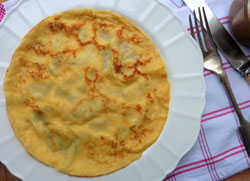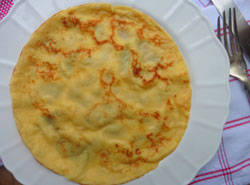Perfect Pancakes with or Without Snow!

It seems pancakes are another favourite during Lockdown number 3. I must put up my Mum’s classic pancake recipe asap but until then here’s a lovely and unusual one for snow pancakes, based on an old Cumbrian recipe.
If it is snowing outside and it’s the dry, powdery kind, you can nip out with a bowlful of pancake batter and add a handful of snow to lighten it as they once did in the Lake District.
The resulting pancakes are very light but no worries if there’s no snow, you can use sparkling mineral water, or plain tap water, instead.
Snow pancakes were often partnered with Cumberland rum butter and it’s a winning combination and well worth trying.
See Cumberland Rum Butter recipe
Alternatively serve with lemon and sugar or your favourite pancake toppings.
The spoonful of butter helps make your batter smooth as well as delicious, by the way.
Makes around 6 pancakes
- 110g (4oz)plain flour
- 2 medium-large eggs
- 200ml (7 floz) milk
- 1 level tablespoon salted butter, melted and cooled slightly
- 100g (4oz) fresh, clean snow or 100ml (3½ floz) sparkling mineral water
- Extra butter for greasing pan
- Rum butter to serve
You will need a sturdy 20cm frying pan or crepe pan: non-stick is ideal
Sieve the flour into a roomy bowl.
Make a well in the centre and break in the eggs.
Stir in the flour with a dinner fork.
Add 30-40ml (1 floz or a little more) of milk and stir to combine.
Gradually add the melted butter and once smooth change to a balloon whisk.
Whisk in the remaining milk gradually.
Next, either, add the snow and leave overnight, or until the snow has melted, then whisk the batter again thoroughly.
Or, gradually whisk in the mineral water.
Aim for a completely smooth batter, the consistency of thin cream.
Heat the pan until moderately hot (turn hob dial to 4 or equivalent) and lightly grease with butter.

Pour in a soup ladleful of batter and swirl around the pan until evenly distributed.
Leave until large uneven bubbles appear on the surface and the pancake will move freely round the pan.
Toss, or flip over with a spatula.
Keep an eye on the heat and turn it down if necessary.
Cook the second side for a few moments until it will move freely.
Serve immediately or stack on a warm plate and keep hot.